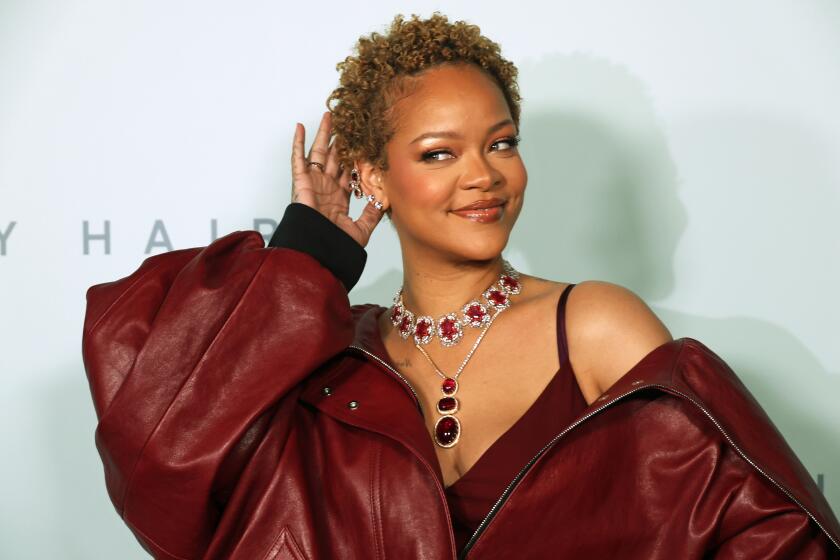Making Toys That Don’t Ignore Asians
Teacher Leelee Chou, 27, flipped through the catalog and saw a part of childhood she had missed--a Korean doll in traditional hanbok dress.
Chou, whose ancestry is half-Chinese and half-Korean, grew up in an upper-middle-class white neighborhood in Upland.
“As a kid, I played with Barbies. It was subliminally ingrained in me that this was beauty. This was to be valued. I didn’t have a Korean doll,” said Chou, a sixth-grade teacher at Belvedere Middle School in the Los Angeles Unified School District.
Now, in her classroom and with her own child, Chou turns to Asia for Kids, which says it is the largest mail-order company of its kind in the country. The catalog offers ethnic dolls, crafts, books and other items featuring Asian languages and culture, such as an anthology of Hmong folk tales and a CD of Cambodian court music with English translations of the Khmer lyrics.
A Cincinnati mother of two who started the catalog four years ago with 100 stapled copies has built the company’s mailing list to 1 million people worldwide. More than 25% of the company’s customers live in Southern California, its biggest market.
Companies such as Asia for Kids are responding to demographics showing the impact of Asian Americans, along with new Asian immigrants, as consumers. In California, for instance, people of Asian ancestry are the state’s fastest-growing and best educated in terms of school level completed, according to the U.S. Census Bureau. Asian Americans also have the highest average household income at $46,695, according to the latest bureau statistics.
“More and more companies are starting to recognize the importance of Asian American consumers--that they have not only an influence on the people in their communities but that they’re a link to people in Asia,” said Bill Imada, president of Imada Wong Communications Group, a Los Angeles-based marketing communications firm specializing in Asian Americans.
For instance, Imada pointed out, New York Life Insurance Co. offers a Chinese-language Web site. “It’s not just Monterey Park anymore,” with its proliferation of Chinese-language signs and businesses catering to the majority Asian population, he said.
Yet, researchers have found, images of Asian Americans in everything from advertisements to dolls are still hard to find in most of the country (the Toy Manufacturers of America does not track the production or sales of ethnic dolls and toys).
“What happens is that images kids form of what constitutes desirable physical features, desirable social behaviors and cultural behaviors are based on Euro American norms,” said clinical psychologist Derald Sue, who studies multicultural psychology and mental health at Cal State Hayward. “And yet they know where they come from is racially and culturally different. What happens is an insidious process. They begin to view their own racial and cultural heritage as handicapped. . . . They form a very negative self-image of themselves.”
*
In one study, with Cal State Hayward graduate student assistants, Sue worked with 6- and 7-year-old boys and girls of Chinese descent in San Francisco’s Chinatown. He handed them dolls that had typical Asian features or white features. What he found mirrored similar studies done by other researchers on African American children and dolls--the kids identified the white dolls as good and the Asian dolls as bad, and said the white dolls were most like themselves.
It’s important, Sue said, for toy companies and other businesses catering to children to offer products that reflect the ethnic makeup of U.S. neighborhoods and schools.
“This is not just for Asian Americans or Asian American kids,” he said. “This is to get Euro American kids to really recognize that they will have to grow up and go out and function in a pluralistic society. And as long as they are unaware of what these groups are like, they are not provided the tools to be multicultural.”
Chou, the teacher, doesn’t plan to buy her 18-month-old son only books and games from one culture.
“Not just Asia products and Asian books but African American books and Hispanic culture books,” Chou said. “To live in a society where we are so diverse, with the whole issue of hate crimes and racism and tolerance. . . . I don’t plan on raising my son in Koreatown.”
Chou, who is a stamp collector, also buys stamps from Asia for Kids to show students at her school in East Los Angeles and engage them in talk about countries that they might not know much about.
Half of Asia for Kids’ customers are non-Asian, said founder Selina Yoon, who commissioned marketing studies of the clientele.
“It’s an interest to teach their kids to be more global,” said Yoon, 40. “They may have neighbors who are Asian or work with people from other countries.”
Other customers include adoption agency directors who include a copy of the catalog with orientation kits for new parents, many of whom adopt from Asian countries; schoolteachers with primarily white students and Chinese parents in China who have trouble finding English-language books for children in their country.
Iris Jue, who was born in Hong Kong, bought her 6-year-old daughter a translation of original stories on the Chinese heroine, Mulan.
“I wanted my daughter to know what the real story was as opposed to just knowing the Disney version,” said Jue, 44. “I don’t make a big point of her being Chinese . . . but I was glad to see there is something out like this [catalog].”
*
Some items are aimed at adults, such as a book describing weddings in Chinese, Korean and Japanese cultures, with details on the bride and groom’s clothes, toasts and flowers.
One of the books that caught Nancy Nojima’s eye was a biography of Olympic figure skating champion Kristi Yamaguchi, who is Japanese American.
“It was affirming to see my culture represented,” said Nojima, 44, a homemaker in Westchester and third-generation Japanese American.
Yoon, who was born in Korea, founded the company out of frustration. In Cincinnati, she and her husband, who is Chinese American, could not find books or other materials to teach Korean and Chinese to their 4-year-old son or 2-year-old daughter. Friends in Los Angeles could not help, and Yoon could not turn anything up on trips to Taiwan and Hong Kong.
In 1994, Yoon quit her job as a marketing manager at Procter & Gamble to devote herself to the search. She hooked up with suppliers such as a Chinese American mother in Northern California who began making Chinese dolls after she couldn’t find one for her daughter. (That doll, Baby June, in a red cotton dress, is still one of the catalog’s bestselling products.)
Yoon also began collecting products representing other Asian cultures in her basement, eventually traveling to 10 countries on buying expeditions. In fall 1995, she compiled the company’s first hand-stapled catalog at home. Now, the company ships to 50 states and 30 countries and has more than $1 million in annual sales. Other catalogs feature similar products but none match the size of Asia for Kids, which carries more than 1,000 products, Yoon said.
“When people find us, they’re so moved,” she said. “They’re like, ‘Where have you been?’ ”
*
* For information on Asia for Kids, call (800) 888-9681 or log on to https://www.asiaforkids.com.
* Renee Tawa can be reached at renee.tawa@latimes.com.
More to Read
Inside the business of entertainment
The Wide Shot brings you news, analysis and insights on everything from streaming wars to production — and what it all means for the future.
You may occasionally receive promotional content from the Los Angeles Times.






